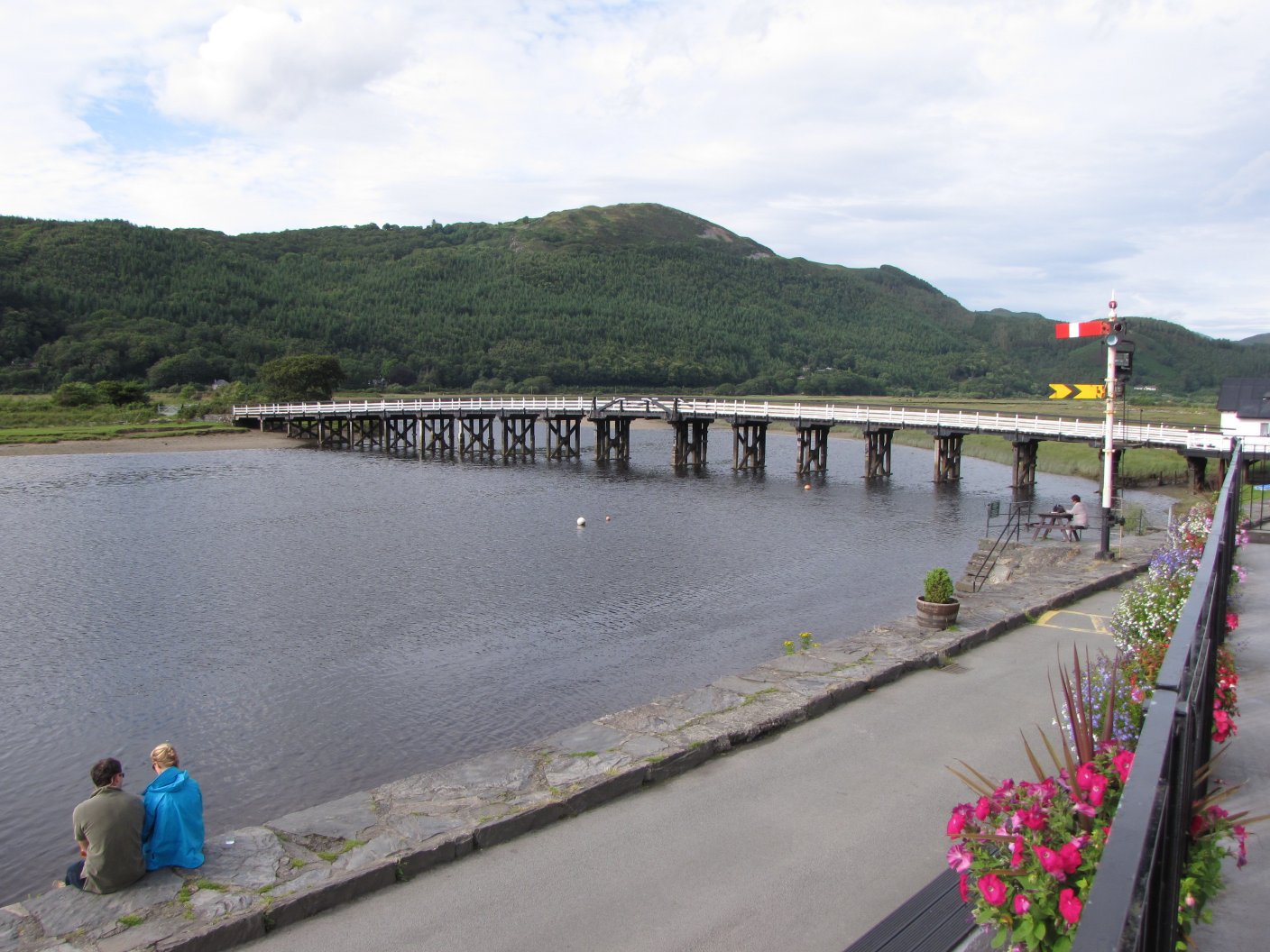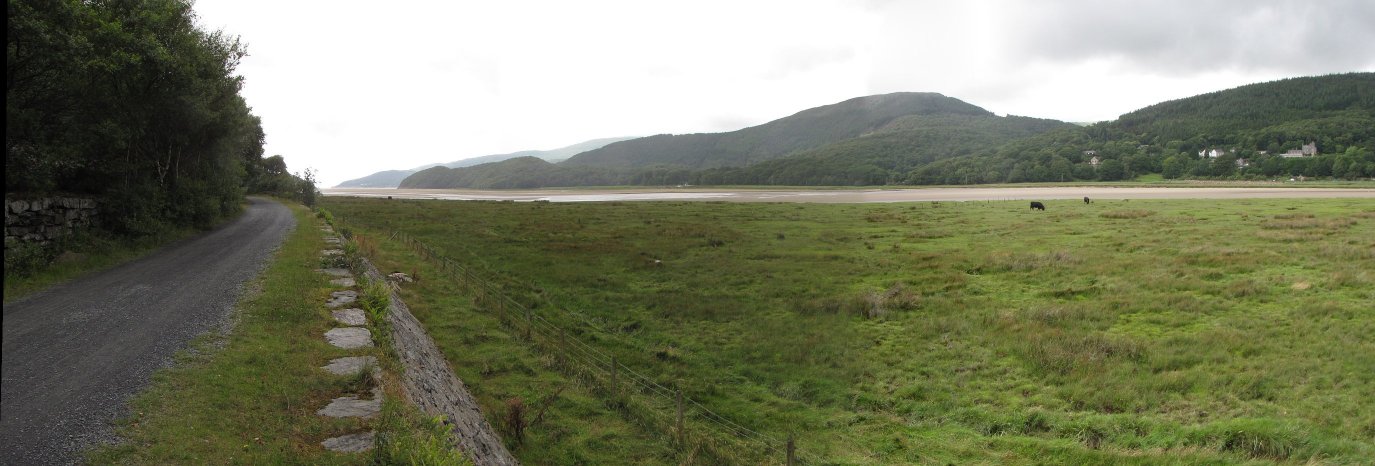|
Penmaenpool
Penmaenpool (Welsh: Llynpenmaen) is a hamlet on the south side of the estuary of the River Mawddach in Wales, near Dolgellau. A Grade II listed toll bridge provides access across the estuary for light vehicles. Points of interest Penmaenpool toll bridge is a wooden toll bridge built in 1879 to replace a ferry crossing. It links the A493 running along the south bank of the Mawddach to the A496 running along the north. It is Cadw-registered and was Grade II listed in 1990. The bridge can only be used by vehicles under 2.5 tonnes, and around 200 crossings are made each day. The George III Inn was originally two buildings: a ship chandler serving the boatbuilding industry, and a pub. It dates from approximately 1650. Gerard Manley Hopkins reputedly wrote the poem entitled "Penmaen Pool" in the visitor's book. Penmaenpool railway station was on the Aberystwith and Welsh Coast Railway. It opened as Penmaen Pool on 3 July 1865, and closed to goods on 4 May 1964 and passengers on ... [...More Info...] [...Related Items...] OR: [Wikipedia] [Google] [Baidu] |
Penmaenpool Railway Station
Penmaenpool railway station at Penmaenpool in Gwynedd, North Wales, was formerly a station on the branch of the Aberystwith and Welsh Coast Railway, part of the Ruabon to Barmouth Line. It closed to passengers on Monday 18 January 1965. It had two platforms and a passing loop, plus an engine shed approximately half a mile west of the station next to the former fireman's house. According to the Official Handbook of Stations the following classes of traffic were being handled at this station in 1956: G, P, F, L, H & C and there was no crane.1956, ''Official Handbook of Stations'', British Transport Commission The site today The station is now occupied by a car park, but the original station signal box remains next to the Penmaenpool Toll Bridge and was used by the RSPB as an observation post and information centre for the local nature reserve. The former station master's house, ticket office and waiting room has been converted into an annexe for the George III hotel. Photograp ... [...More Info...] [...Related Items...] OR: [Wikipedia] [Google] [Baidu] |
Aberystwith And Welsh Coast Railway
The Aberystwith and Welsh Coast Railway was a standard gauge railway company, running a line along the west coast of Wales. The railway was planned to run between Anglicised place name spellings were used during most of the history of the line, and are used here for consistency. and , and on to Porth Dinllaen, with branches to and . These branches joined the Bala and Dolgelly Railway and Newtown and Machynlleth Railway respectively. There were two major river bridges planned: the Dovey Bridge, across the River Dovey, and the Barmouth Bridge, over the River Mawddach. The former proved impracticable to build, so an altered route was built from to , near Glandyfi, forming a Y-shaped network. Parliamentary powers were also obtained on multiple occasions for a line from Pwllheli to Porth Dinllaen, though this was never built. The routes were opened progressively between 1863 and 1869. The company was absorbed into Cambrian Railways in 1865. Continuous shortages of money delayed ... [...More Info...] [...Related Items...] OR: [Wikipedia] [Google] [Baidu] |
Dolgellau
Dolgellau () is a town and Community (Wales), community in Gwynedd, north-west Wales, lying on the River Wnion, a tributary of the River Mawddach. It was the traditional county town of the Historic counties of Wales, historic county of Merionethshire ( cy, Meirionnydd, Sir Feirionnydd) until the county of Gwynedd was created in 1974. Dolgellau is the main base for climbers of Cadair Idris and Mynydd Moel which are visible from the town. Dolgellau is the second largest settlement in southern Gwynedd after Tywyn and includes the community of Penmaenpool. Etymology The name of the town is of uncertain origin, although ' is Welsh for "meadow" or "dale", and ' (soft mutation of ') means "grove" or "spinney", and is common locally in names for farms in sheltered nooks. This would seem to be the most likely derivation, giving the translation "Grove Meadow". It has also been suggested that the name could derive from the word ', meaning "cell", translating therefore as "Meadow of [monks' ... [...More Info...] [...Related Items...] OR: [Wikipedia] [Google] [Baidu] |
Mawddach Trail
The Mawddach Trail ( cy, Llwybr Mawddach) is a cycle path route, part of Lôn Las Cymru, which runs for some from Dolgellau to Morfa Mawddach railway station , by Barmouth bridge on the Cambrian coast. It is maintained by the Snowdonia National Park and is popular with walkers and cyclists alike. It passes some estuarine areas that are important for water birds, and the RSPB Information Centre at Penmaenpool makes use of the old signal box as an observation centre overlooking the estuary. The cycle route is a rail trail running along the former trackbed of the Ruabon to Barmouth branch line of the Great Western Railway. This line closed under the Beeching Axe The Beeching cuts (also Beeching Axe) was a plan to increase the efficiency of the nationalised railway system in Great Britain. The plan was outlined in two reports: ''The Reshaping of British Railways'' (1963) and ''The Development of the ... in the 1960s. External linksGwynedd Council - Recreational Rou ... [...More Info...] [...Related Items...] OR: [Wikipedia] [Google] [Baidu] |
River Mawddach
The Afon Mawddach ( en, River Mawddach, italic=yes) is a river in Gwynedd, Wales, which has its source in a wide area north of Dduallt in Snowdonia. It is 28 miles (45 km) in length, and is much branched; many of the significant tributaries are of a similar size to the main river. The catchment area is bounded to the east by the Aran Fawddwy massif and to the west and north by the Harlech dome which forms a watershed just south of Llyn Trawsfynydd. The Mawddach has been the site of significant industrialisation and land management. Gold mining and subsequently gold panning have had major impacts but forestry, the preparation of animal skins, the storage of old munitions and the use of hill-sides as artillery ranges have all added to the legacy of pollution. The river is also very ''flashy'' - prone to very rapid rise and fall in level depending on rainfall. Rainfall can also be very heavy and it falls on very base-poor soils leading to episodes of strongly depre ... [...More Info...] [...Related Items...] OR: [Wikipedia] [Google] [Baidu] |
Cader Idris
Cadair Idris or Cader Idris is a mountain in the Meirionnydd area of Gwynedd, Wales. It lies at the southern end of the Snowdonia National Park near the town of Dolgellau. The peak, which is one of the most popular in Wales for walkers and hikers, is composed largely of Ordovician igneous rocks, with classic glacial erosion features such as cwms, moraines, striated rocks, and roches moutonnées. Etymology ''Cadair Idris'' means 'Idris's Chair'. Idris is usually taken to be the name of a giant or, alternatively, it may refer to Idris ap Gwyddno (or Gweiddno), a 7th-century prince of Meirionnydd who won a battle against the Irish on the mountain. Idris ap Gwyddno was in fact referred to as ''Idris Gawr'' ("Idris the Giant") in some mediaeval genealogies of Meirionydd. The basic meaning of the word ''cadair'' (Middle Welsh/Early Modern Welsh ''kadeir'' or ''cadeir'') is 'seat, chair' (borrowed from the Greek ''cathedra'' 'chair'). In place names ''cadair'' can mean 'strongho ... [...More Info...] [...Related Items...] OR: [Wikipedia] [Google] [Baidu] |
Villages In Gwynedd
A village is a clustered human settlement or community, larger than a hamlet but smaller than a town (although the word is often used to describe both hamlets and smaller towns), with a population typically ranging from a few hundred to a few thousand. Though villages are often located in rural areas, the term urban village is also applied to certain urban neighborhoods. Villages are normally permanent, with fixed dwellings; however, transient villages can occur. Further, the dwellings of a village are fairly close to one another, not scattered broadly over the landscape, as a dispersed settlement. In the past, villages were a usual form of community for societies that practice subsistence agriculture, and also for some non-agricultural societies. In Great Britain, a hamlet earned the right to be called a village when it built a church. [...More Info...] [...Related Items...] OR: [Wikipedia] [Google] [Baidu] |
Barmouth
Barmouth ( cy, Abermaw (formal); ''Y Bermo'' (colloquial)) is a seaside town and community in the county of Gwynedd, northwestern Wales, lying on the estuary of the Afon Mawddach and Cardigan Bay. Located in the historic county of Merionethshire, the Welsh form of the name is derived from ''aber'' (estuary) and the river's name, "Mawddach". The English form of the name is a corruption of the earlier Welsh form ''Abermawdd''. The community includes the villages of Llanaber, Cutiau, and Caerdeon. History The town grew around the shipbuilding industry, and more recently as a seaside resort. Notable buildings include the medieval tower house, the 19th century roundhouse prison and St John's Church. William Wordsworth, a visitor to Barmouth in the 19th century, described it thus: "With a fine sea view in front, the mountains behind, the glorious estuary running inland, and within compass of a day's walk, Barmouth can always hold its own against any rival." (Citade ... [...More Info...] [...Related Items...] OR: [Wikipedia] [Google] [Baidu] |
Gerard Manley Hopkins
Gerard Manley Hopkins (28 July 1844 – 8 June 1889) was an English poet and Jesuit priest, whose posthumous fame placed him among leading Victorian poets. His prosody – notably his concept of sprung rhythm – established him as an innovator, as did his praise of God through vivid use of imagery and nature. Only after his death did Robert Bridges publish a few of Hopkins's mature poems in anthologies, hoping to prepare for wider acceptance of his style. By 1930 Hopkins's work was seen as one of the most original literary advances of his century. It intrigued such leading 20th-century poets as T. S. Eliot, Dylan Thomas, W. H. Auden, Stephen Spender and Cecil Day-Lewis. Early life and family Gerard Manley Hopkins was born in Stratford, EssexW. H. Gardner (1963), ''Gerard Manley Hopkins: Poems and Prose'' Penguin p. xvi. (now in Greater London), as the eldest of probably nine children to Manley and Catherine Hopkins, née Smith. He was christened at the Anglican churc ... [...More Info...] [...Related Items...] OR: [Wikipedia] [Google] [Baidu] |
Ship Chandler
A ship chandler is a retail dealer who specializes in providing supplies or equipment for ships. Synopsis For traditional sailing ships, items that could be found in a chandlery include sail-cloth, rosin, turpentine, tar, pitch, linseed oil, whale oil, tallow, lard, varnish, twine, rope and cordage, hemp, and oakum. Tools (hatchet, axe, hammer, chisel, planes, lantern, nails, spike, boat hook, caulking iron, hand pump, and marlinspike) and items needed for cleaning such as brooms and mops might be available. Galley supplies, leather goods, and paper might also appear. In the age of sail ship chandlers could be found on remote islands, such as St. Helena, who were responsible for delivering water and fresh produce to stave off scurvy. Today's chandlers deal more in goods typical for fuel-powered commercial ships (oil tanker, container ship, and bulk carrier A bulk carrier or bulker is a merchant ship specially designed to transport unpackaged bulk cargo — such as ... [...More Info...] [...Related Items...] OR: [Wikipedia] [Google] [Baidu] |
Cadw
(, a Welsh verbal noun meaning "keeping/preserving") is the historic environment service of the Welsh Government and part of the Tourism and Culture group. works to protect the historic buildings and structures, the landscapes and heritage sites of Wales, to make them available for the public to visit, enjoy, and understand their significance. manages 127 state-owned properties and sites. It arranges events at its managed properties, provides lectures and teaching sessions, offers heritage walks, and hosts an online shop. Members of the public can become members of to gain membership privileges. Aims and objectives As the Welsh Government's historic environment service, is charged with protecting the historic environment of Wales, and making it accessible to members of the public. To this end, in 2010–11 it identified four aspects of its work: it would take measures to conserve the heritage of Wales, its ancient buildings, and monuments; it would aim to sustain the di ... [...More Info...] [...Related Items...] OR: [Wikipedia] [Google] [Baidu] |





.jpg)




